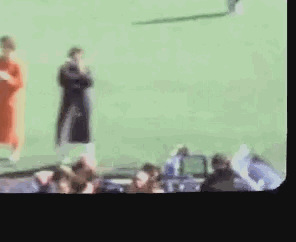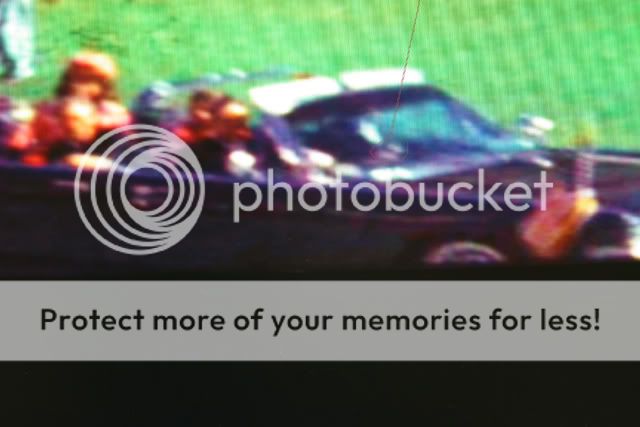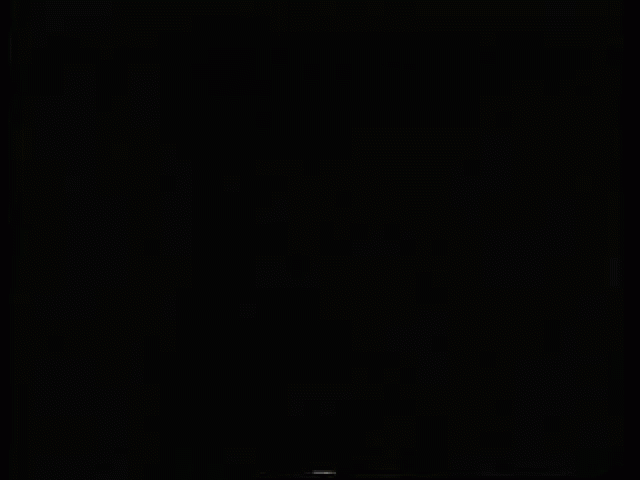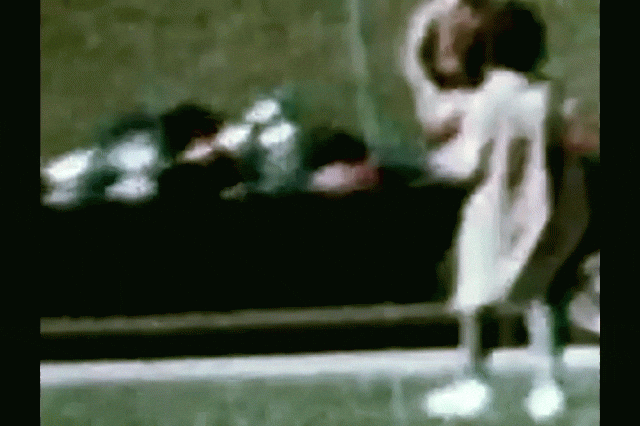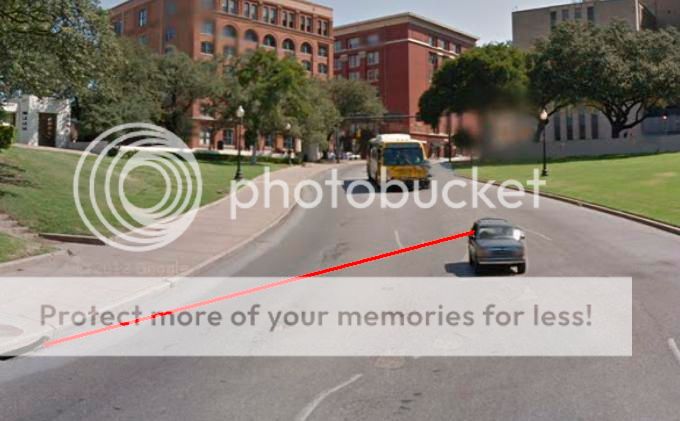Brazen Deception by Bill Smith of the Secret Service:
Bill Smith of the Secret Service (and yes, Homer McMahon did express some degree of whimsical, bemused doubt about his true identity) [20] lied his eyes out to Homer McMahon about the origins of the assassination film he brought to NPIC with him from Hawkeyeworks in Rochester, New York. We know definitively from the examination of the four briefing board panels by both Homer McMahon and Ben Hunter, in the summer of 1997, that Bill Smith did bring with him to NPIC a version of the Zapruder film, and not some other film. This is crucially important, for from this basic fact we know that Bill Smith of the Secret Service lied to Homer McMahon and Bill Hunter about a number of things: (1) he lied when he said a private citizen donated the assassination film out of patriotism because he did not want to make any money on it; for Abraham Zapruder was determined to make as much money as he could off of the film, and did; (2) he lied when he said he carried the undeveloped film to Rochester and had it developed at Hawkeyeworks; for it is well documented that the camera-original Zapruder film was developed at the Kodak Plant in Dallas on Friday, November 22, 1963; (3) clearly, the film brought to NPIC from Hawkeyeworks by Bill Smith was created there, but it was not just developed it was a re-creation of the Zapruder film after its alteration at that facility, intended to masquerade as an original out-of-camera, unslit (16 mm wide), double 8 film. It had to have been produced in an aerial-imaging optical printer with an animation stand affixed, such as that shown in Figures 9.4 and 9.5 of Professor Raymond Fielding's seminal 1965 textbook, The Technique of Special Effects Cinematography (Focal Press, Fourth Edition, 1985). The technique undoubtedly used aerial imagery was widely employed in Hollywood during the 1950s and 1960s, and can be read about on pages 224-232.
Those orchestrating the Zapruder film cover-up the weekend of the assassination were determined to call in a different work crew when the altered film (now reassembled optically in an aerial imaging optical printer as an unslit, 16 mm wide double 8 film again) was returned to NPIC the night after Brugioni's briefing board event. The goal was obviously to make a sanitized set of briefing boards, from the sanitized film, which would now necessarily be absent the more egregious evidence of frontal shots, and therefore of crossfire, and conspiracy. This need is the only reasonable explanation for calling in a different work crew and telling them that the work was need-to-know and above Top Secret, and that not even their bosses were allowed to know what activity they had been involved in. Simply put, it was easy to fool McMahon and Hunter and whoever assembled the four panel briefing boards using their prints; the hard part, and the necessary part, was to keep the Brugioni team ignorant of the activity of the McMahon team. This succeeded remarkably well because of the culture of secrecy within the Agency, and Brugioni never found out about the second NPIC event until 2009. McMahon, who cannot be located today in 2012, and who is presumably deceased, never found out about it. This does not speak well for Arthur Lundahl, or Navy Captain Pierre Sands, however, who both must have understood the Big Picture, and known what was afoot at the facility they managed.
So the operative question remains, did the Hawkeyeworks facility have the capability to perform aerial imaging? Was there an optical printer with an aerial imaging animation stand installed, present at Hawkeyeworks?
Hawkeyeworks Explained:
After the Homer McMahon interview was released in 1998, JFK researchers loyal to the concept of an authentic Zapruder film that is ground truth in the Kennedy assassination downplayed the importance of the Hawkeyeworks story, either doubting its existence because there was no documentary proof, or alternately saying that the Hawkeyeworks lab was solely dedicated to U-2 and Corona satellite photography. But these critics were wrong on both counts.
First, Dino Brugioni, during his 2009 and 2011 interviews with Peter Janney and me, not only confirmed the existence of the state-of-the-art Kodak lab in Rochester used by the CIA for various classified purposes, but confirmed that he visited the place more than once, including once prior to the JFK assassination. (He also confirmed its existence in his recent book, Eyes in the Sky, on page 364.) Second, Dino Brugioni made clear to me, when I interviewed him in July of 2011, that the Hawkeye Plant (as he called it) was an enormous state-of-the-art private sector laboratory founded and run by Kodak, which performed far more tasks than just Corona satellite and U-2 special order film services. He said that the Hawkeye Plant was involved in developing new film products and in manufacturing and testing special film products of all kinds, including new motion picture films, and that it definitely had the capability to process motion pictures. He did not see such equipment himself, but was told by Ed Green, a high-ranking Kodak manager at Hawkeyeworks with whom he had a relationship of trust, that the Hawkeye Plant could, and did, definitely process motion pictures. When repeatedly questioned about this capability by Peter Janney throughout the 2009 interviews, Brugioni said with great reverence, on several occasions, They could do anything. [21]
The CIA refused to provide me with any information about Hawkeyeworks when the Agency finally responded to my September 12, 2009 Freedom of Information Act (FOIA) request on February 7, 2011. But that was hardly surprising, since over one year earlier, on January 27, 2010, the CIA wrote to me, cautioning: The CIA Information Act, 50 U.S.C. Section 431, as amended, exempts CIA operational files from the search, review, publication, and disclosure requirements of the FOIA. What this meant, in rather blunt language, was that if the CIA was running an op, such as the alteration of the Zapruder film immediately after JFK's assassination, then they didn't have to search for those records or tell me about it, in any way. So the failure by the CIA to answer any of my many questions about Hawkeyeworks means literally nothing.
The plain facts are these: (1) the 8 mm (already slit!) camera-original Zapruder film was delivered to NPIC late on Saturday evening, 11/23/63, and the two Secret Service officials who brought it to NPIC for the making of briefing boards left with the film at about 3 AM Sunday morning; and (2) a 16 mm, unslit version of the Zapruder film was returned to NPIC the next night, after dark, on Sunday evening, 11/24/63; and its courier ( Bill Smith ) said it had been processed at Hawkeyeworks, and that he had brought it directly to NPIC in Washington, D.C. from Rochester (using the unmistakable code word Hawkeyeworks ) himself.
Double 8 home movies which have already been slit at the processing facility do not miraculously reassemble themselves from two 25-foot strips 8 mm in width, and connected with a splice in the middle, into 16 mm wide unslit double 8 films. A new Zapruder film was clearly created at Hawkeyeworks in Rochester, in an optical printer. Bill Smith told the truth when he said the film he carried had been developed there at Hawkeyeworks; he lied when he said that it was the camera-original film taken by the photographer in Dallas.
If Hawkeyeworks truly had the physical capability to do anything, as Ed Green informed Dino Brugioni, then all that would have been required that weekend would have been to bring in some experienced personnel an animator or two, and a visual effects director experienced in the black arts of Hollywood. Those personnel, if not already on-site, employed at Hawkeyeworks, could have been brought into Rochester on Saturday, November 23rd, the same day the JFK autopsy photographs were being developed in Washington, D.C. at Naval Photographic Center, Anacostia. The JFK autopsy photos developed on Saturday (per Robert Knudsen's 1978 HSCA deposition transcript) would have provided the guide for the image alteration necessary on the Zapruder film the next day, on Sunday. The JFK autopsy photos document the massive head wound created by clandestine, post mortem surgery on JFK's head wounds at Bethesda Naval Hospital, and would have provided a rough guide for the massive head wound in the top and right side of the skull that had to be painted onto selected Zapruder film frames the next day, on Sunday. No such parietal-temporal-frontal wound was seen at Parkland Hospital in Dallas by any of the treatment staff the day Kennedy was shot and treated there, but it had to be added to selected Zapruder film frames, to match the illicit post mortem cranial surgery at Bethesda that was being misrepresented in the autopsy photos as damage from the assassin's bullet. [22] In addition to painting on a false wound, of course, the forgers at Hawkeyeworks would have had to obscure black out the real exit wound, in the right rear of JFK's head, that was seen in Trauma Room One at Parkland Hospital. (More on this below.)
What is undeniable is that there are undisputed facts on the ground which indicate that an optically edited Zapruder film a re-creation arrived at NPIC in Washington, D.C. on Sunday night, 11/24/63, after the film had been in Rochester, at Hawkeyeworks, all day long. Remember, the two Secret Service officials who had the original 8 mm camera-original film departed NPIC with the film at about 3 AM (4 AM at the latest) on Sunday morning. They may have been at Hawkeyeworks with the film as early as 6 AM; and since the Zapruder film did not reappear at NPIC until well after dark on Sunday evening, approximately 12 hours (or more) may have been available to those at Hawkeyeworks who were engaged in its alteration.
A final comment here: those who insist upon injecting Hollywood expertise into the equation here, must respect the facts on the ground. The film that arrived at NPIC Sunday night did not come from anywhere else other than Rochester, N.Y. it was not couriered from Hollywood, or New York City, or anywhere else other than Rochester it came from Hawkeyeworks, per the words of the courier who brought it to NPIC Sunday night, Bill Smith. And the code word Hawkeyeworks meant one thing only the state-of-the-art, Top Secret Kodak lab located at Kodak Headquarters, in Rochester, New York. Hollywood talent may very well have been involved in altering the Zapruder film, but if so, it was talent employed at the Kodak facilities at Hawkeyeworks in Rochester.
The Two NPIC Zapruder Film Events: Signposts Pointing to the Film's*Alteration ? LewRockwell.com

